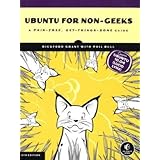
Average Reviews:

(More customer reviews)I have toyed occasionally with both Red Hat and Ubuntu over the years, but I definitely meet the definition of "non-geek." Installing these operating systems before always required some degree of struggle, and not uncommonly (especially with some earlier distros) I would simply fail. But that has changed. The current 8.04 version of Ubuntu partnered with this book is frankly outstanding.
First, a word about the operating system: this Ubuntu distro, code-named Hardy Heron, may well be the one that has finally made Linux as easy as Windows. I had always previously laughed at such claims from Linux enthusiasts, but this distro impresses me. It is the one that may at last enable me to defenestrate completely. And this guidebook is the perfect match, using normal language. One thing that it does very well is explaining what the few text commands that it uses actually do, instead of just instructing the reader to type it into the command line and leaving you wondering what exactly those "magic words" meant. There is a single short chapter about using the command line, but 99% of what the guidebook leads you through uses the GUI, so if the command line intimidates you never fear.
I installed Ubuntu 8.04 dual-boot with Windows XP on my laptop effortlessly. Not a single thing went awry. The new partitioning tool that is used during the installation is a great improvement over those in any of the (few) other Linux distros I've seen. The book follows step by step. My laptop is about 4 years old, so I am sure that a newer laptop may have hardware that is not as well supported and effortless. But on mine everything just worked, including my wireless internet.
Though they are enthusiastic, sometimes getting an understandable answer from the Linux community can be challenging. I had always struggled through installing Linux software before, especially if I needed to compile it myself. In fact, I can count my successful compilations on one hand. I never knew that GUI-based tools like Synaptic Package Manager or GNOME App Install were available to make it all so easy (assuming that a deb package is available, as there usually is) and again the book walks you through flawless examples. One example used for software installation is a program to automatically detect and load a driver for any ATI or NVIDIA graphics card- something which has historically been very difficult on Linux systems
My biggest criticism- and it wasn't enough to cost half a star or anything like that- is that the CD included with the book only has the i386 version of Ubuntu. If you want the 64-bit version you have to download it and burn the ISO to disc. (In fairness, the i386 version will load and run on a 64-bit machine, but only in 32-bit mode.) One of the reasons I bought this book was that I can't seem to pass the checksum when I downloaded the ISO, so now I am waiting for my disc from Canonical so that I can install Ubuntu on my desktop.
So, if you describe yourself as a "computer user" rather than a "computer geek," this is an outstanding book. If you know enough to know that Ubuntu exists then you almost certainly possess the minimal computer savvy required to use this book. I know that this review sort of morphed into a review of Ubuntu in addition to the book, but it is difficult to separate them. Suffice to say, the book walks you step-by-step through multiple examples of everything that you have to do. It also explains such details as what the differences are between the various file formats in which Open Office Word Processor can save documents. Almost all of such important minutiae are covered.
EDIT:
I wanted to respond to the 3-star review by Domestic Wolverine, which is the lowest rating that this book has gotten as of the time I am writing this. Mr Wolverine noted, correctly, that this book made certain assumptions about it's readers: It assumes, for example, that one knows what a computer is, knows (generally) how to use a mouse, and has at least encountered a GUI (windows with a lower-case w) in the past. This is an accurate description of the book. However, I do not feel that it is a valid CRITICISM of the book. It is, after all, titled "Ubuntu for Non-Geeks" rather than "Ubuntu for Hermits Who Have Lived in a Cave for the Past Three Decades." Mr Wolverine has, correctly, pointed out that this book might start at a level of discussion about a millimeter beyond the comprehension of someone who, essentially, doesn't know what a computer is. But I must point out that such people were not the targeted demographic. Such a book targeting hermits would be a very different work, and much larger, and be cluttered with a LOT of space devoted to material that 99% of westerners would just skip over. I laud Mr Wolverine for conceding that, other than this one deficiency, the book rates 5 stars. But I think that the book hit its intended target demographic perfectly.
Click Here to see more reviews about: Ubuntu for Non-Geeks: A Pain-Free, Get-Things-Done Guide
Click here for more information about Ubuntu for Non-Geeks: A Pain-Free, Get-Things-Done Guide

0 comments:
Post a Comment